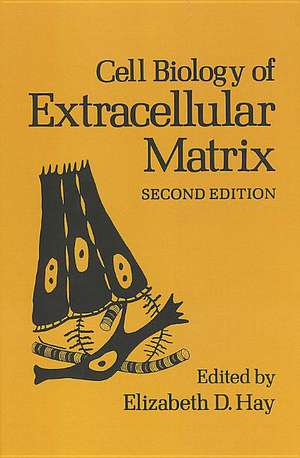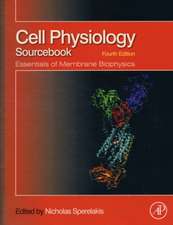Cell Biology of Extracellular Matrix: Second Edition
Editat de E.D. Hayen Limba Engleză Hardback – 30 dec 1991
| Toate formatele și edițiile | Preț | Express |
|---|---|---|
| Paperback (1) | 1226.39 lei 6-8 săpt. | |
| Springer Us – 20 oct 2012 | 1226.39 lei 6-8 săpt. | |
| Hardback (1) | 1238.56 lei 6-8 săpt. | |
| Springer Us – 30 dec 1991 | 1238.56 lei 6-8 săpt. |
Preț: 1238.56 lei
Preț vechi: 1510.44 lei
-18% Nou
Puncte Express: 1858
Preț estimativ în valută:
237.03€ • 246.55$ • 195.68£
237.03€ • 246.55$ • 195.68£
Carte tipărită la comandă
Livrare economică 14-28 aprilie
Preluare comenzi: 021 569.72.76
Specificații
ISBN-13: 9780306439513
ISBN-10: 0306439514
Pagini: 468
Ilustrații: XVII, 468 p. 266 illus., 1 illus. in color.
Dimensiuni: 178 x 254 x 33 mm
Greutate: 1.04 kg
Ediția:1991
Editura: Springer Us
Colecția Springer
Locul publicării:New York, NY, United States
ISBN-10: 0306439514
Pagini: 468
Ilustrații: XVII, 468 p. 266 illus., 1 illus. in color.
Dimensiuni: 178 x 254 x 33 mm
Greutate: 1.04 kg
Ediția:1991
Editura: Springer Us
Colecția Springer
Locul publicării:New York, NY, United States
Public țintă
ResearchDescriere
In the ten-year interval since the first edition of this volume went to press, our knowledge of extracellular matrix (ECM) function and structure has enor mously increased. Extracellular matrix and cell-matrix interaction are now routine topics in the meetings and annual reviews sponsored by cell biology societies. Research in molecular biology has so advanced the number of known matrix molecules and the topic of gene structure and regulation that we won dered how best to incorporate the new material. For example, we deliberated over the inclusion of chapters on molecular genetics. We decided that with judicious editing we could present the recent findings in molecular biology within the same cell biology framework that was used for the first edition, using three broad headings: what is extracellular matrix, how is it made, and what does it do for cells? Maintaining control over the review of literature on the subject of ECM was not always an easy task, but we felt it was essential to production of a highly readable volume, one compact enough to serve the the student as an introduction and the investigator as a quick update on graduate the important recent discoveries. The first edition of this volume enjoyed con hope the reader finds this edition equally useful. siderable success; we D. Hay Elizabeth vii Contents Introductory Remarks 1 Elizabeth D. Hay PART I. WHAT IS EXTRACELLULAR MATRIX? Chapter 1 Collagen T. F. Linsenmayer 1. Introduction . . . . . . . . . . . . . . . . . . . . . . . . . . . . . . . . . . . . . . . . . . . . . . . . . . 7 2. The Collagen Molecule . . . . . . . . . . . . . . . . . . . . . . . . . . . . . . . . . . . . . . . . 8 2. 1. Triple-Helical Domain(s) . . . . . . . . . . . . . . . . . . . . . . . . . . . . . . . . . .
Cuprins
Introductory Remarks.- I. What Is Extracellular Matrix?.- 1 Collagen.- 2 Proteoglycans: Structure and Function.- 3 The Elastic Fiber.- 4 Fibronectin and Other Cell Interactive Glycoproteins.- II. How Do Cells Produce the Matrix?.- 5 Proteoglycans: Metabolism and Pathology.- 6 Collagen Biosynthesis.- 7 Matrix Assembly.- 8 Extracellular Matrix Degradation.- III. What Does Matrix Do for Cells?.- 9 Proteoglycans and Hyaluronan in Morphogenesis and Differentiation.- 10 Integrins as Receptors for Extracellular Matrix.- 11 The Glomerular Basement Membrane: A Selective Macromolecular Filter.- 12 Collagen and Other Matrix Glycoproteins in Embryogenesis.








